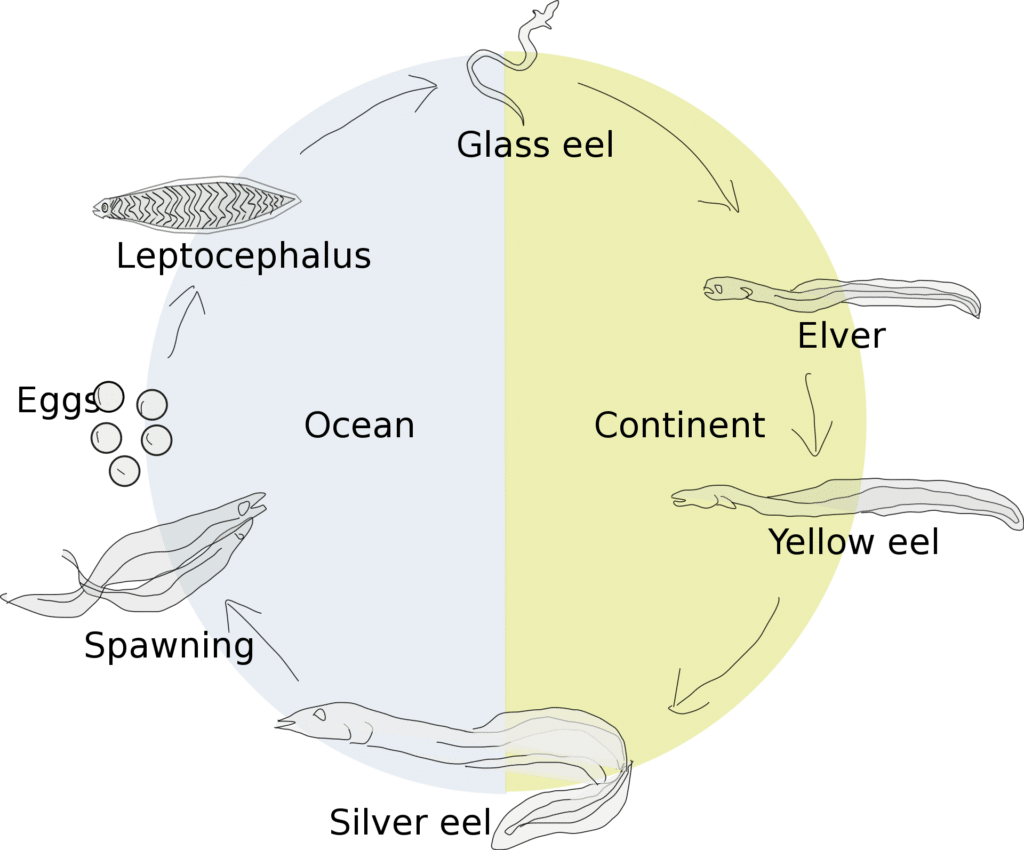Have you ever heard of Eels? Yeah, we’re talking about the really weird snake-like fish that sometimes electrocute people. Sidebar, electric eels actually aren’t even eels. They’re a totally different kind of fish, it’s a misnomer. Even if you cast out the infamous electric eel, the fish are incredibly odd because no one knows where they come from. These sea creatures lack reproductive organs of any kind. Their lack of obvious reproductive organs has enshrouded eels for thousands of years. Some of history’s greatest minds have tried to solve the mystery. Scientists believe they know the lifecycle of the eel today, but people have believed to know the whole story before. This is the story of the incredibly strange eel.
The Mystery of the Eel
Eels are a prevalent species. There are many variations and they are everywhere. Yet, this vast species shows no clear form of reproduction. The curious life cycle of the American Eel has baffled scientists for centuries. Its European counterpart has caused confusion for millennia.
Aristotle believed they spawned from the mud. Other philosophers posited the possibility of spontaneous generation. One noteworthy thinker theorized that they were born when an adult eel scraped along rocks on the seafloor. The flakes of eel skin would then morph into adolescent eels. So, yeah, no real satisfactory theories were out there.
One young researcher went so far as to spend 10 hours a day dissecting the strange fish in an effort to find something that pointed to the reproduction. Day in and day out he would travel to the local pier and purchase all the eels available. He spent so much time with the nasty creatures that he seemed to start to hallucinate and see them everywhere. This man was a young Sigmund Freud. Honestly, this backstory explains a lot about the storied psychoanalyst.
The Truth About Sea Serpents
French zoologist Yves Delage is most known for his work in the study of invertebrates, but also famous for discoveries relating to the ear canal and a rather speculative claim regarding the Turin Shroud. He kept a leptocephalus in his lab in 1886. One morning, to his shock, he found that his leptocephali had undergone a metamorphosis overnight. This was the first step in the discovery of the lifecycle of the eel. His claims were later confirmed by other observes who asserted that saltwater was a necessary component of their development.
The Quest to Find the Birthplace of the Eel
Over time, it became clear that all previously discovered subspecies of eels were instead one step on the evolutionary lifecycle of the eel. Eels would begin their lives in a larval stage and undergo many transformations throughout their life, similar to frogs or butterflies. What remained a mystery was where are the mature eels and where are the infant eels? Remember, no eel had ever been discovered with reproductive organs. Likewise, no birthplace or mating ground had ever been discovered.
In the early spring of 1904, Johannes Schmidt began what would become a life-long obsession. He purchased a boat and dedicated himself to the research of eels. He vowed he would not return from his expedition until he discovered the birthplace and lifecycle of the illustrious invertebrate. Nearly 20 years later he had enough information to infer where the mating grounds of all eels were located, despite never observing the ritual or any mature eels or any infant eels.
So, Where Do Eels Come From?
Thanks to the work of Schmidt the regularly accepted theory today is as follows. Leptocephali, the larval form of American and European eels, begin their lives in the Sargasso Sea. This location is significant for a few reasons. First, it is quite literally a sea within the Atlantic Ocean. The sea is bound by a series of currents in the area that form this very odd sea within a sea. Second, this is the Bermuda Triangle. Yeah, that Bermuda Triangle. Conspiracy theorists rally around this truth claiming eels to be from anything from aliens to demons to government devices.
The Leptocephali then cross the ocean and undergo their first metamorphosis into the translucent glass eel. Immediately after this transformation, the eel makes its way inland transitioning from saltwater to freshwater. The change in environment brings about the second transformation into an elver. Elvers swim along rivers and eventually into the lake water. Once they find a place to settle the eels transition into the form of the Yellow Eel. After many years in this phase, the Yellow Eels begin a migration back towards the Ocean. Eventually, making its final metamorphosis into a Silver Eel.

Photo courtesy of Wikipedia
It is believed that the Silver Eels make the journey back to the Sargasso Sea where they grow their reproductive organs, mate, lay eggs, and then die off. However, no Silver Eel has ever been observed in the Sargasso Sea or en route to the Sargasso Sea from America or Europe. Needless to say, skeptics doubt this generally accepted lifecycle.
Conclusion
Eels are so weird. That’s really all anyone can say for sure about them. These slithery fish have confused history’s greatest minds from Aristotle to Freud. Even though modern science claims to understand them conspiracy theorists doubt their claims. But, let’s be honest, what claims do scientists make that isn’t doubted by conspiracy theorists? If it were true, the lifecycle of the eel is truly incredible. If it were true. Find out more about Eels on this Episode of Things I Learned Last Night.
Things I Learned Last Night is an educational comedy podcast where best friends Jaron Myers and Tim Stone talk about random topics and have fun all along the way. If you like learning, and laughing a whole lot while you do, then you’ll love TILLN. Watch or listen to this episode right now!
Sources
How Are Baby Eels Made? – New Scientist
Where do Eels Come From? – The New Yorker
Related Episodes
Tell Us What You Think of This Content!
Don’t forget to share with your friends!

